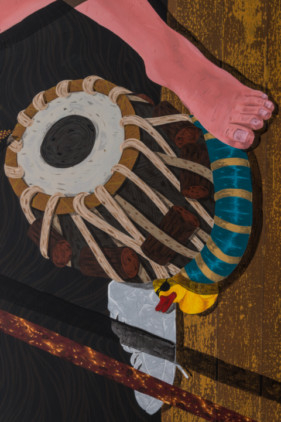
Amir Fallah’s latest exhibition in Dubai, “The Collected”, presents an unusual take on the idea of commissioned portraits and on the very concept of a portrait.
All the paintings in the show are portraits commissioned by Dubai-based collectors. But, although the patrons had paid in advance, they only got to see their portraits for the first time at the opening of the show. The portraits are unusual too. Rather than creating a physical depiction of the patrons, Fallah has chosen to represent their identity and personal history through various objects belonging to them. The subjects in his mixed media paintings appear in dramatic neoclassical poses, surrounded by personal elements such as a favourite book, an object of sentimental value or a pattern they like.
Their faces and bodies are concealed, yet the paintings say a lot about their personality, interests, relationships and lifestyle. This unique experiment by the US-based Iranian artist is an exploration of the complex relationship between patronage and art making, collector and artist, and the dynamics of the creative process in today’s art world.
In an interview with Weekend Review, Fallah explained his interesting concept and methodology. Excerpts:
What was the idea behind this show?
Throughout history, influential and wealthy patrons have always commissioned artists to create their portraits. But the artist was merely a tool for realising the patron’s own vision of themselves in these vanity projects or propaganda pieces. I wanted to liberate this classical form of art making from those outdated notions and make it more of a collaborative project. The staging of the show was like a performance and the public revelation of the artworks added an element of surprise.
What process did you use to create these portraits?
I visited the home of each collector and we spent several hours together talking about the things that define them and that they value. They told me interesting stories about various objects in their homes and showed me things that had sentimental value for them or some special meaning. These were mundane everyday things that we surround ourselves with and can be called the debris of life, such as an artefact bought on a trip, an old blanket gifted by a loved one, a houseplant or a much used tattered pair of sneakers. I staged the portrait, with several such objects arranged around the subject, whose face was covered by a garment belonging to them or a fabric from their home. I then photographed the setting and used these images as a starting point. There was no more interaction with the collectors while I worked on the paintings in my studio in Los Angeles.
Why did you want to hide the face?
I wanted to remove everything that we traditionally associate with a portrait — likeness, gender, age, and skin colour. And I wanted to connect on a deeper level with who they are.
How did those images develop into these portraits?
While transferring the images to canvas, I did my own interventions and interpretation to tell the patrons’ personal histories through my eyes. For instance, in one painting I blew up a bronze lion-shaped paperweight to make it look like a life-size lion guarding the patron. And I included some objects he had collected in Germany before moving to Dubai, as a reference to that part of his life. In some paintings I have superimposed patterns from the floor or wall in the home or a favourite handkerchief, or collaged in flowers from the wall paper or a picture of an organ that the subject was emotionally attached to in his childhood home. In one collector’s home I noticed a special photograph of his late father and I represented it in his portrait as an aura, capturing the essence of the strong emotions connected with the image without reproducing it. Another subject spoke about feeding the birds in her garden. So I researched the birds commonly found in the UAE and painted some of them into her portrait. I also added little details such as showing the time a subject was born on her grandfather’s pocket watch in her portrait.
Are the decorative borders in the paintings a reference to your own Persian heritage?
It is a reference to Persian miniature painting where the decorative borders act as windows into the story. They also work as visual guides to take the viewers in and out of different spaces in my paintings.
What was the reaction of the collectors?
They were very supportive of the idea. This was a situation where everybody was vulnerable. The collectors had paid for something without knowing how it would turn out. And I was nervous about their reaction. Fortunately, they were all happy with their portraits and everyone at the preview enjoyed the guessing game of identifying the subjects. The experiment also worked on another level by giving me the opportunity to get to know my collectors in a deeper way. I like the idea that once they take the portraits home, my patrons will continue to find new details in them. And I hope that even those who do not know these patrons well will find the paintings engaging and interesting.
–Jyoti Kalsi is an arts enthusiast based in Dubai
The Collected will run at The Third Line, Al Quoz until January 23.











